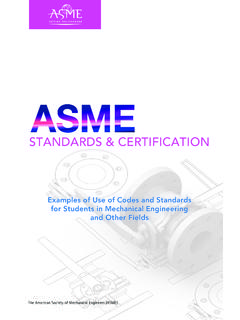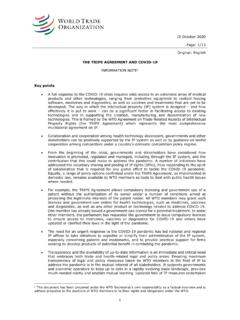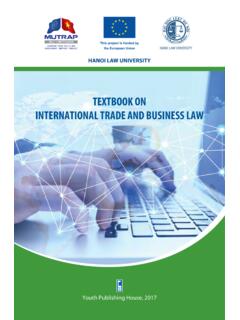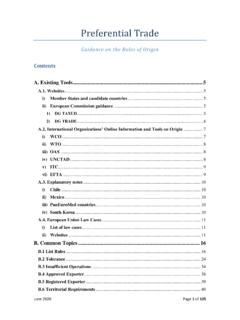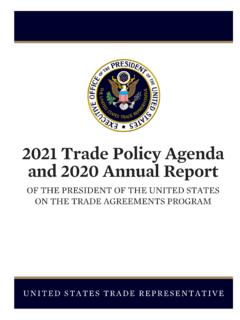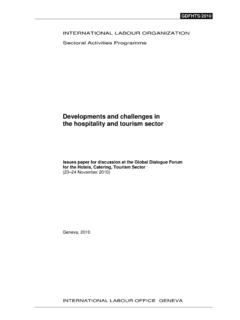Transcription of INTERCONNECTED ECONOMIES: BENEFITING FROM GLOBAL …
1 INTERCONNECTED ECONOMIES: BENEFITING FROM GLOBAL VALUE CHAINS SYNTHESIS REPORT 2 INTERCONNECTED ECONOMIES: BENEFITING FROM GLOBAL VALUE CHAINS SYNTHESIS REPORT OECD 2013 FOREWORD The international fragmentation of production in GLOBAL value chains (GVCs) challenges the way we look at the GLOBAL economy. It is essential to understand how GVCs work, how they affect economic performance, and what policies help to derive greater benefits from them. This publication sets out the main evidence and policy implications of the OECD's work on GVCs, including trade policy, investment policies, innovation policies, and framework and structural policies that affect how, and to what extent, countries, including emerging and developing economies, can benefit from participation in GVCs.
2 The OECD s interest in GVCs and their impacts on national economies is far from new. At the 2004 Ministerial Council Meeting, Ministers considered that the OECD could help to dispel fears about the increased outsourcing of industrial production often outside the OECD area. They felt that a systematic empirical overview of trends and developments was lacking even though the political concerns are high on the policy agenda in many OECD countries. In 2007, the OECD Directorate for Science, Technology and Industry published Staying Competitive in the GLOBAL Economy: Moving up the Value Chain, accompa-nied by a collection of papers bundled in Staying Competitive in the GLOBAL Economy: Compendium of Studies on GLOBAL Value Chains.
3 A summary of the reports was presented at the OECD Ministerial meeting in May 2007. This work was the basis for a much broader programme of work in which different OECD directorates have participated. The Directorate for Science, Technology and Industry, the trade and Agriculture Directorate, the Statistics Directorate, and the Directorate for Financial and Enterprise Affairs all contributed to this publication. Comments and inputs were also provided by the Development Centre and the Directorate for Development Co-operation, in particular on the role of GVCs in economic development (Chapter 5). At the same time, the OECD and the world trade organization (WTO) joined forces to produce new estimates of international trade ( measured in value added instead of gross terms).
4 The OECD-WTO Initiative on trade in Value Added (TiVA) aims to provide solid evidence to underpin the identification of policy issues and responses in an era of GVCs. The first results were launched in January 2013, followed by a second release covering more years, countries and indicators in May 2013. The OECD and the WTO will continue to update this database, improve its quality and reliability, and extend the industrial and geographical coverage. Owing to the cross-directorate character of the OECD work on GVCs, the different chapters of this publication were discussed and declassified by various OECD Committees including the Committee on Industry, Innovation and Entrepreneurship (CIIE), which took the lead in this work, the trade Committee, the Committee on Statistics and the Investment Committee.
5 The comments and inputs formulated by national delegates to these OECD official bodies are gratefully acknowledged. 3 INTERCONNECTED ECONOMIES: BENEFITING FROM GLOBAL VALUE CHAINS SYNTHESIS REPORT OECD 2013 This synthesis report containing the main policy messages was discussed by the OECD Executive Committee and OECD Council and was presented at the OECD Ministerial Council Meeting of May 2013. A large number of OECD staff contributed to this work. Both the volume and the synthesis report were written under the directorship of Andrew Wyckoff, Ken Ash and Martine Durand. Dirk Pilat provided overall guidance and was responsible for the synthesis report. The volume was co-ordinated by Koen De Backer who is also the (co-)author of Chapter 1 (The Rise of GLOBAL Value Chains), Chapter 5 (The Role of GLOBAL Value Chains in Economic Development), Chapter 6 ( GLOBAL Value Chains and Competitiveness), Chapter 7 (Upgrading in GLOBAL Value Chains The Role of Knowledge-Based Capital) and Chapter 8 ( GLOBAL Value Chains Managing the Risks).
6 Other (co-)authors of this report are Nadim Ahmad (Chapter 2 Measuring trade in Value Added), S bastien Miroudot and Doroth e Rouzet (Chapter 3 Implications of GLOBAL Value Chains for trade Policy), Mike Gestrin (Chapter 4 GLOBAL Value Chains and International Investment) and Naomitsu Yashiro (Chapter 7 Upgrading in GLOBAL Value Chains The Role of Knowledge-Based Capital). Isabelle Desnoyers-James, Laurent Moussiegt and Alexandros Ragoussis prepared the statistical/econometric work. The study benefited significantly from the input and comments of Carlos Alvarez, Andrea Beltramello, Crawford Falconer, Frans Lammersen, Carlo Menon, Jose Ramon Perea, Karine Perset, Raed Safadi and Paul Schreyer.
7 Florence Hourtouat and Sarah Ferguson provided secretarial support. Julia Gregory and Joseph Loux prepared the final manuscript for publication. The empirical evidence presented in this publication builds heavily on the joint OECD-WTO trade in Value Added Initiative. The cooperation with the WTO in developing the TiVA initiative is greatly acknowledged. The OECD-WTO cooperation has greatly benefited from related work on the EU-supported world Input-Output Database (WIOD) and by researchers at the United States International trade Commission (USITC) and the Institute of Developing Economies Japan External trade Organisation (IDE-JETRO). The TiVA initiative was developed on the basis of the OECD Input-Output Database, which has benefited from the financial support of Japan over time.
8 The OECD TiVA project team consisted of Norihiko Yamano, Nadim Ahmad, S bastien Miroudot, Colin Webb, Agnes Cimper, Guannan Miao, Doroth e Rouzet and Bo Werth. Their input is particularly acknowledged as the new TiVA results have provided much needed empirical evidence on the importance and effects of GVCs in today s GLOBAL economy. For further information GLOBAL Value Chains Contact: trade in Value-Added Contact: 4 INTERCONNECTED ECONOMIES: BENEFITING FROM GLOBAL VALUE CHAINS SYNTHESIS REPORT OECD 2013 TABLE OF CONTENTS INTERCONNECTED ECONOMIES: BENEFITING FROM GLOBAL VALUE CHAINS .. 5 Key policy messages .. 5 1. GLOBAL VALUE CHAINS: EVIDENCE AND IMPACTS .. 8 What are GLOBAL value chains?
9 8 Why have GLOBAL value chains emerged? .. 9 How are economies involved in value chains? .. 11 trade in value chains differs from regular trade and requires new measurement .. 14 GLOBAL value chains strengthen productivity and growth .. 19 2. DERIVING THE BENEFITS: WHAT IMPLICATIONS FOR POLICY? .. 23 Integration in GLOBAL value chains requires openness to international trade .. 23 Open, transparent and predictable investment policies facilitate integration .. 29 Participation in value chains requires a conducive business environment .. 32 Engagement in GLOBAL value chains can support economic development .. 33 Upgrading in GVCs requires supportive policies .. 37 Investment in knowledge-based capital can support the upgrading process .. 39 GVCs affect policies to enhance competitiveness.
10 44 The costs of adjustment can be mitigated by sound labour market and skills policies .. 46 The risks of value chains need to be managed by business and governments .. 47 Looking ahead national policy in an INTERCONNECTED world .. 53 Figures Figure 1. GLOBAL Value Chains: from apparel to electronics .. 10 Figure 2. Participation in GVCs, 2009 .. 12 Figure 3. Shares in total exports of OECD and Key Partner economies, 2009 .. 16 Figure 4. Ratio of domestic value added to gross exports, OECD and Key Partner economies, 2005 and 2009 .. 17 Figure 5. Share of services value added in total gross exports, 2009 .. 18 Figure 6. Income derived from GVCs, selected economies, 1995 and 2009 .. 20 Figure 7. Tariffs on the gross and the domestic value-added of exports1 (2009).










